Introduction
In recent years, the global shift toward sustainable transportation has become one of the most significant environmental and economic trends. Among the many solutions, electric vehicles (EVs) stand out as one of the most promising alternatives to traditional internal combustion engine vehicles. The global push to reduce carbon emissions, combat climate change, and reduce reliance on fossil fuels has led governments around the world to introduce and intensify green policies aimed at accelerating the adoption of EVs. This article explores how various countries’ green policies are influencing the expansion of electric vehicles and what changes we can expect in the next few years.
1. The Role of Green Policies in Accelerating EV Adoption
1.1 What Are Green Policies?
Green policies refer to a range of government initiatives, regulations, and incentives designed to encourage environmental sustainability. In the automotive industry, green policies typically focus on reducing emissions, promoting the use of clean energy, and incentivizing the adoption of electric vehicles over traditional gasoline or diesel-powered vehicles.
Some of the most common green policies supporting EV adoption include:
- Subsidies and Tax Incentives: Direct financial incentives to lower the upfront cost of electric vehicles, including subsidies, tax rebates, and purchase incentives.
- Emission Standards and Regulations: Legislation that sets strict emissions limits for vehicles, pushing automakers to adopt cleaner technologies.
- Charging Infrastructure Development: Investment in the expansion of public and private EV charging networks to make electric vehicle ownership more convenient.
- Research and Development Funding: Government-funded programs to support innovation in battery technology, autonomous driving, and energy-efficient transportation.
- Bans on Fossil Fuel Vehicles: Some countries have announced plans to phase out the sale of gasoline and diesel-powered vehicles within the next few decades.
1.2 The Impact of Green Policies on EV Adoption
Green policies play a crucial role in accelerating the adoption of electric vehicles, as they directly address the barriers that often prevent consumers from switching to EVs. These policies help lower the cost of electric vehicles, build the necessary infrastructure, and create a supportive regulatory environment for consumers and manufacturers alike.
2. Green Policies by Region: A Global Perspective
2.1 Europe: A Leader in EV Adoption and Green Policies
Europe has been at the forefront of adopting green policies to promote electric vehicles. The European Union (EU) has set ambitious targets for carbon neutrality by 2050, and electric vehicles are seen as a critical component of achieving this goal.
- EU’s Green Deal and Emission Targets: The European Green Deal aims to make Europe the first climate-neutral continent by 2050. A significant part of this plan involves reducing transport emissions, with the EU aiming for a 55% reduction in transport sector emissions by 2030. The European Commission has set a target that by 2035, all new cars sold in the EU will be zero-emission vehicles.
- Incentives for Consumers: Many European countries offer subsidies, tax breaks, and purchase incentives for electric vehicle buyers. For instance, Norway, one of the leaders in EV adoption, offers various benefits, including exemptions from value-added tax (VAT) and road tolls, free public parking, and access to bus lanes.
- Charging Infrastructure: Countries like the Netherlands, Germany, and France have significantly expanded their charging networks, ensuring that EV drivers have easy access to charging stations. The EU has also set a goal to have 1 million public charging stations by 2025.
2.2 China: The World’s Largest EV Market
China has become the largest market for electric vehicles globally, with robust green policies aimed at both domestic adoption and global leadership in EV technology.
- Government Subsidies: The Chinese government offers substantial subsidies for EV purchases and has implemented tax breaks for manufacturers to incentivize local production. Furthermore, local governments in many cities offer additional incentives, including rebates and access to preferential lanes.
- Automaker Support: China has created a supportive ecosystem for domestic EV manufacturers like BYD, NIO, and XPeng, helping them achieve significant growth in both the domestic and international markets.
- Charging Infrastructure: China has the world’s largest network of charging stations, with over 1.5 million charging points across the country. The government continues to expand this network as part of its strategy to encourage EV adoption.
2.3 United States: Growing Commitment to EVs Under New Leadership
The United States has seen a resurgence in support for electric vehicles, especially under the Biden administration, which has made climate change and sustainability key priorities.
- Biden’s EV Plan: President Joe Biden has set a goal to ensure that half of all new vehicles sold in the U.S. by 2030 will be zero-emission vehicles. This plan involves strengthening incentives for EV purchases, investing in charging infrastructure, and pushing for stricter fuel efficiency standards.
- State-Level Initiatives: Many U.S. states, including California, Washington, and New York, have introduced their own EV policies, such as banning the sale of new gasoline-powered vehicles by 2035. California has been particularly aggressive in implementing zero-emission vehicle mandates for automakers.
- Private Sector Collaboration: The U.S. government has also partnered with private companies, including automakers and tech giants, to invest in EV development and infrastructure. Tesla’s success, in particular, has sparked further interest in the sector.
2.4 Other Regions: Trends in India, Japan, and Beyond
While Europe, China, and the U.S. have dominated the EV policy conversation, other regions are also making strides in supporting electric vehicles.
- India: The Indian government has introduced several measures to promote EV adoption, including tax breaks for manufacturers and consumers, and policies aimed at expanding charging infrastructure. However, challenges such as affordability and infrastructure development remain significant.
- Japan: Japan has long been a leader in hybrid vehicle technology, and the government is now focusing on accelerating EV adoption. Japan offers various incentives, including tax rebates, and is investing heavily in research and development of next-gen battery technology.
- The Middle East: Countries like the UAE and Saudi Arabia are beginning to promote EVs as part of their long-term diversification efforts away from oil dependency. The UAE, for example, is investing in a charging network to make EVs more accessible.

3. The Future of EVs: What Changes Can We Expect in the Next Few Years?
3.1 Further Integration of Green Policies
- Stricter Emission Regulations: Many governments are expected to continue tightening emission standards for internal combustion engine vehicles. This will drive automakers to shift further toward electric vehicles to comply with these regulations.
- Increased Investment in Charging Infrastructure: Governments will likely continue to invest in expanding charging infrastructure to ensure that EV adoption is not hindered by limited charging options.
- Faster Phasing Out of Gasoline and Diesel Vehicles: In the next few years, more countries are expected to announce or implement bans on the sale of new gasoline and diesel vehicles. Countries like the UK and France have already set dates for this, and other countries may follow suit.
3.2 Technological Advancements
- Battery Technology: Innovations in battery technology, particularly in solid-state batteries, are expected to reduce costs, increase range, and shorten charging times. This will address some of the remaining barriers to EV adoption, making them more appealing to consumers.
- Autonomous Vehicles and EVs: The convergence of autonomous driving technology with electric vehicles could lead to the rise of shared mobility services using self-driving EVs. This will reshape the future of transportation, particularly in urban areas.
3.3 Global Cooperation on Climate Goals
- International Agreements: We can expect greater international collaboration on climate goals, with countries aligning their green policies to meet global targets such as those outlined in the Paris Agreement. This cooperation will likely accelerate the transition to electric vehicles.
- Global EV Supply Chain Development: As demand for electric vehicles grows, a global supply chain for EVs, including batteries and components, will become more robust. This will reduce costs and increase availability, making EVs more accessible worldwide.
Conclusion
Green policies have already played a pivotal role in accelerating the adoption of electric vehicles, and their impact will only grow in the coming years. As more governments commit to ambitious climate goals and implement stricter emission regulations, the popularity of EVs is set to rise further. In the next decade, we can expect a world where electric vehicles are the norm rather than the exception, driven by a combination of government policies, technological innovations, and changing consumer preferences. The transition to electric mobility is not just a trend but a fundamental shift in how the world approaches transportation, sustainability, and environmental responsibility.











































